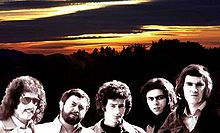- Museo Rosenbach
-
Museo Rosenbach 
Museo Rosenbach in the 1970s.Background information Origin Italy Genres Italian progressive rock Years active 1971–1974, 199?–present Labels Dischi, BMG, Carisch, Musea Website www.museo.it Members Giancarlo Golzi
Alberto Moreno
Marco Balbo
Marioluca Bariona
Andrea BiancheriPast members Andrea Pavan
Sergio Cossu
Pit Corradi
Stefano Galifi
Enzo MerognoMuseo Rosenbach is an Italian progressive rock band whose album Zarathustra, in spite of the limited success it scored in the 1970s, is today considered a cornerstone of the genre.
Contents
History
Museo Rosenbach was formed around 1971 as Inaugurazione del Museo Rosenbach ("The Inauguration of Rosenbach Museum") when two bands, La Quinta Strada and Il Sistema joined forces. La Quinta Strada and Il Sistema had played mostly songs by other popular artists like Jimi Hendrix and rock groups such as The Kinks, The Animals and Steppenwolf and by Rhythm & Blues stars like Otis Redding and Wilson Pickett.
The band name may have been inspired by Premiata Forneria Marconi and Banco del Mutuo Soccorso. If these other bands had named themselves after a bakery and a bank, the band thought it was reasonable to create a "Museum" dedicated to the German publisher Otto Rosenbach. Other possible inspirations for the name may have come from the eclectic collections of the Rosenbach Museum & Library in Philadelphia, PA or simply the poetic name "Rosenbach", which means "brook of roses" in German.
Influenced by Pink Floyd and Banco del Mutuo Soccorso (among others), Museo Rosenbach released their first and most well-known album Zarathustra in April 1973. The songs on Zarathustra displayed the influence of classical music and the heavy keyboard passages (synthesizer, mellotron and Hammond organ) typical of other Italian progressive rock groups of the time and of progressive rock in general. Vocalist Stefano Galifi's distinctive voice and keyboard player Pit Corradi added originality to the band sound.
The band provoked controversy for their supposed right-wing inclinations stemming from the image of Mussolini found in the collage on the album cover, and the Nietzsche-inspired lyrics.
The band's first lineup was short-lived, disbanding soon after the release of Zarathustra and after some live concerts in 1973. Their second album of new material, Exit, was released in 2000. Of the founding members, only Alberto Moreno and Giancarlo Golzi remained. This album was considered more commercial than Zarathustra.
In 2002 Museo Rosenbach took part in an experiment, first proposed by the Finnish magazine Colussus, to interpret the Finnish poem Kalevala in rock music. The short suite "Flower of Revenge" was composed for this project.
The former member who enjoyed the greatest success in his solo career was drummer Giancarlo Golzi, who joined the pop band Matia Bazar.
Lineups
1973 lineup
- Stefano Galifi - vocals
- Enzo Merogno - guitar, vocals
- Pit Corradi - keyboards
- Alberto Moreno - bass, piano, mellotron
- Giancarlo Golzi - drums, percussion, vocals
Current lineup
- Alberto Moreno - bass and mellotron
- Giancarlo Golzi - drums
- Marco Balbo - classical and lead guitar
- Andrea Biancheri - vocals
- Marioluca Bariona - keyboards
Discography
- Zarathustra (1973)
- Live '72 (1992 - live)
- Rare and Unreleased (1992 - demos and some previously unreleased tracks)
- Exit (2000)
- "Fiore di Vendetta" song in Kalevala (2003).
External links
- Official site of the band
- Museo Rosenbach on Progboard: Museo Rosenbach album reviews and ratings
- Museo Rosenbach on ProgArchives: Museo Rosenbach album reviews and ratings
- Page with detailed images of the original LP and info for collectors
Categories:- Italian progressive rock groups
Wikimedia Foundation. 2010.
